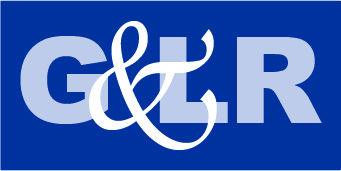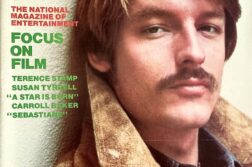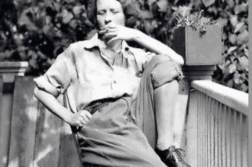WHEN Bob Fosse’s film version of Cabaret, starring Joel Grey as the Master of Ceremonies and Liza Minnelli as Sally Bowles, was released in 1972, it unleashed a new wave of bohemian chic unseen since the 1920’s. Sporting her emerald green fingernails, spidery eyelashes, and garish costumes, Sally’s cry of “Divine decadence, darling!” became the catchphrase for every sort of over-the-top behavior in the decade that eventually gave us disco, punk rock, cocaine, and Studio 54. But where did this demimonde of ambiguous morality and sexuality originate?
The literary genesis of Cabaret begins, of course, with Christopher Isherwood’s Goodbye to Berlin (1939) and The Berlin Stories (1945). The next step was the theatrical adaptation of these works as I Am a Camera, by John Van Druten, which opened on Broadway in 1951—sixty years ago this year—starring Julie Harris as Sally Bowles. The Tony-winning play’s success gave rise to a much less successful movie version in 1955. The idea for a musical rendition can be traced to Sandy Wilson of The Boy Friend fame, but it was Harold Prince who made it happen by hiring John Kander to compose the music and Fred Ebb to write the lyrics for what became the groundbreaking musical Cabaret, which opened on Broadway under Prince’s direction in 1966.
Christopher Isherwood’s protagonist in The Berlin Stories is named—somewhat surprisingly for a work of fiction—Christopher Isherwood. (Equally notable, the protagonist in the book’s companion piece, Mr Norris Changes Trains, is named William Bradshaw, Isherwood’s two middle names.) The Christopher Isherwood of the stories seems to be fairly asexual, as well as British. By the time the story reached Broadway as I Am a Camera, the protagonist, while still named Isherwood and still British, was now ostensibly heterosexual. With the show’s musical incarnation as Cabaret, the protagonist was reborn as an American named Cliff Bradshaw (preserving one of Isherwood’s middle names), who now has an on-again, off-again romance with Sally Bowles. In the Fosse film six years later, the Isherwood character is once again British and renamed Brian Roberts. Now a practicing bisexual, Roberts clearly leans toward being gay. On the other hand, Sally Bowles, once British, is now the American (reportedly due to Minnelli’s inability to act convincingly British). While outwardly heterosexual through most of her incarnations, a recent stage revival had Sally as ambiguously bisexual, taunting other female chorus members, suggesting a pan-sexuality—which, as it happens, had always been the province of the Master of Ceremonies. All of these transformations are elaborated in the second edition of biographer and poet Keith Garebian’s The Making of Cabaret. In the original edition, Garebian adds perspective on some of the most important revivals, including a surprising Harold Prince remake in 1987 (surprising because, according to star Joel Grey, Prince “never redirects a show”) as well as the revered Sam Mendes version of 1993, with Alan Cumming as the Master of Ceremonies and Jane Horrocks (of Absolutely Fabulous renown) as Sally. This was followed by the hugely successful Broadway revival of 1998. And so it goes. Jeffrey Round is a film director and author of the Bradford Fairfax comic mystery series. His latest book, a gay thriller, is Lake on the Mountain: A Dan Sharp Mystery.




